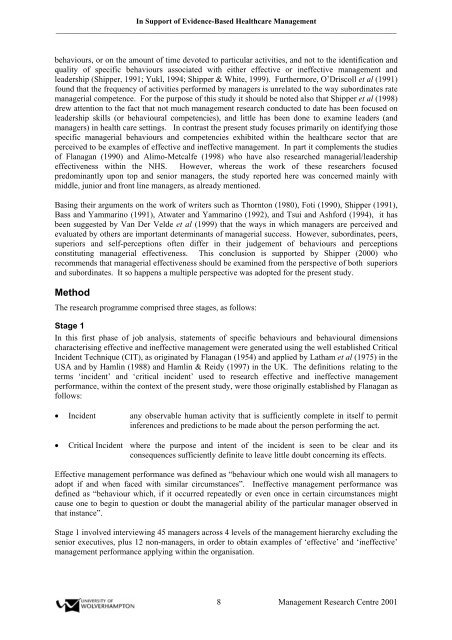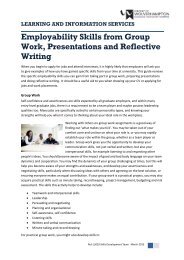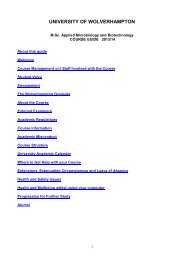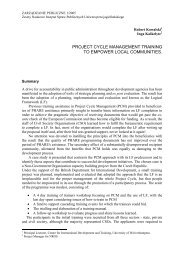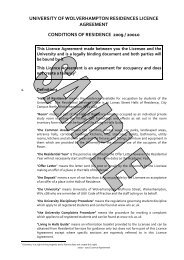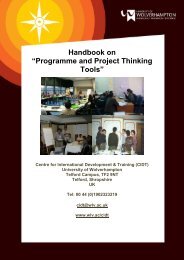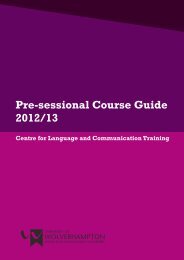In Support of Evidence-Based Healthcare Management: an ...
In Support of Evidence-Based Healthcare Management: an ...
In Support of Evidence-Based Healthcare Management: an ...
- No tags were found...
You also want an ePaper? Increase the reach of your titles
YUMPU automatically turns print PDFs into web optimized ePapers that Google loves.
<strong>In</strong> <strong>Support</strong> <strong>of</strong> <strong>Evidence</strong>-<strong>Based</strong> <strong>Healthcare</strong> <strong>M<strong>an</strong>agement</strong>_________________________________________________________________________________________behaviours, or on the amount <strong>of</strong> time devoted to particular activities, <strong>an</strong>d not to the identification <strong>an</strong>dquality <strong>of</strong> specific behaviours associated with either effective or ineffective m<strong>an</strong>agement <strong>an</strong>dleadership (Shipper, 1991; Yukl, 1994; Shipper & White, 1999). Furthermore, O’Driscoll et al (1991)found that the frequency <strong>of</strong> activities performed by m<strong>an</strong>agers is unrelated to the way subordinates ratem<strong>an</strong>agerial competence. For the purpose <strong>of</strong> this study it should be noted also that Shipper et al (1998)drew attention to the fact that not much m<strong>an</strong>agement research conducted to date has been focused onleadership skills (or behavioural competencies), <strong>an</strong>d little has been done to examine leaders (<strong>an</strong>dm<strong>an</strong>agers) in health care settings. <strong>In</strong> contrast the present study focuses primarily on identifying thosespecific m<strong>an</strong>agerial behaviours <strong>an</strong>d competencies exhibited within the healthcare sector that areperceived to be examples <strong>of</strong> effective <strong>an</strong>d ineffective m<strong>an</strong>agement. <strong>In</strong> part it complements the studies<strong>of</strong> Fl<strong>an</strong>ag<strong>an</strong> (1990) <strong>an</strong>d Alimo-Metcalfe (1998) who have also researched m<strong>an</strong>agerial/leadershipeffectiveness within the NHS. However, whereas the work <strong>of</strong> these researchers focusedpredomin<strong>an</strong>tly upon top <strong>an</strong>d senior m<strong>an</strong>agers, the study reported here was concerned mainly withmiddle, junior <strong>an</strong>d front line m<strong>an</strong>agers, as already mentioned.Basing their arguments on the work <strong>of</strong> writers such as Thornton (1980), Foti (1990), Shipper (1991),Bass <strong>an</strong>d Yammarino (1991), Atwater <strong>an</strong>d Yammarino (1992), <strong>an</strong>d Tsui <strong>an</strong>d Ashford (1994), it hasbeen suggested by V<strong>an</strong> Der Velde et al (1999) that the ways in which m<strong>an</strong>agers are perceived <strong>an</strong>devaluated by others are import<strong>an</strong>t determin<strong>an</strong>ts <strong>of</strong> m<strong>an</strong>agerial success. However, subordinates, peers,superiors <strong>an</strong>d self-perceptions <strong>of</strong>ten differ in their judgement <strong>of</strong> behaviours <strong>an</strong>d perceptionsconstituting m<strong>an</strong>agerial effectiveness. This conclusion is supported by Shipper (2000) whorecommends that m<strong>an</strong>agerial effectiveness should be examined from the perspective <strong>of</strong> both superiors<strong>an</strong>d subordinates. It so happens a multiple perspective was adopted for the present study.MethodThe research programme comprised three stages, as follows:Stage 1<strong>In</strong> this first phase <strong>of</strong> job <strong>an</strong>alysis, statements <strong>of</strong> specific behaviours <strong>an</strong>d behavioural dimensionscharacterising effective <strong>an</strong>d ineffective m<strong>an</strong>agement were generated using the well established Critical<strong>In</strong>cident Technique (CIT), as originated by Fl<strong>an</strong>ag<strong>an</strong> (1954) <strong>an</strong>d applied by Latham et al (1975) in theUSA <strong>an</strong>d by Hamlin (1988) <strong>an</strong>d Hamlin & Reidy (1997) in the UK. The definitions relating to theterms ‘incident’ <strong>an</strong>d ‘critical incident’ used to research effective <strong>an</strong>d ineffective m<strong>an</strong>agementperform<strong>an</strong>ce, within the context <strong>of</strong> the present study, were those originally established by Fl<strong>an</strong>ag<strong>an</strong> asfollows:• <strong>In</strong>cident <strong>an</strong>y observable hum<strong>an</strong> activity that is sufficiently complete in itself to permitinferences <strong>an</strong>d predictions to be made about the person performing the act.• Critical <strong>In</strong>cident where the purpose <strong>an</strong>d intent <strong>of</strong> the incident is seen to be clear <strong>an</strong>d itsconsequences sufficiently definite to leave little doubt concerning its effects.Effective m<strong>an</strong>agement perform<strong>an</strong>ce was defined as “behaviour which one would wish all m<strong>an</strong>agers toadopt if <strong>an</strong>d when faced with similar circumst<strong>an</strong>ces”. <strong>In</strong>effective m<strong>an</strong>agement perform<strong>an</strong>ce wasdefined as “behaviour which, if it occurred repeatedly or even once in certain circumst<strong>an</strong>ces mightcause one to begin to question or doubt the m<strong>an</strong>agerial ability <strong>of</strong> the particular m<strong>an</strong>ager observed inthat inst<strong>an</strong>ce”.Stage 1 involved interviewing 45 m<strong>an</strong>agers across 4 levels <strong>of</strong> the m<strong>an</strong>agement hierarchy excluding thesenior executives, plus 12 non-m<strong>an</strong>agers, in order to obtain examples <strong>of</strong> ‘effective’ <strong>an</strong>d ‘ineffective’m<strong>an</strong>agement perform<strong>an</strong>ce applying within the org<strong>an</strong>isation.8 <strong>M<strong>an</strong>agement</strong> Research Centre 2001


